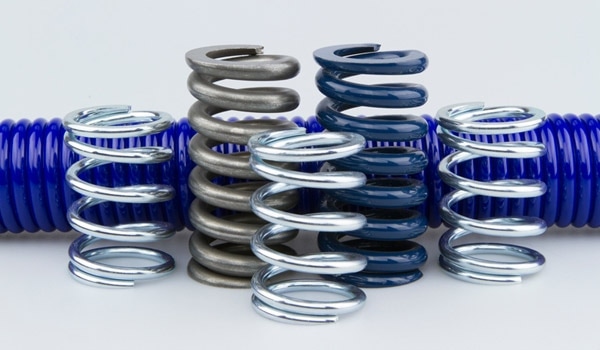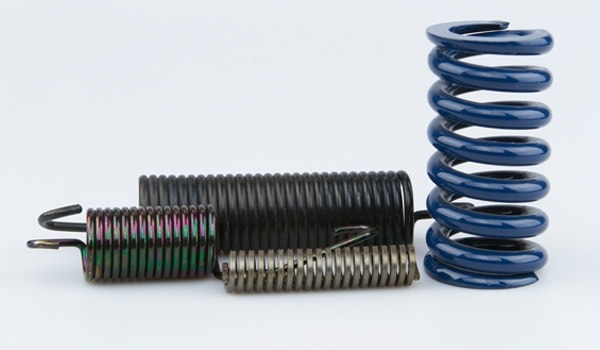Guide to Compression Spring Design
Introduction
Compression springs are very common and used in a broad range of applications. Characterized by an open-coil helical form, compression springs offer resistance to axially applied force. In essence, when force is applied on a compression spring, it pushes back. This occurs because the spring is designed to return to its original resting state when pressure is applied.
The compression spring appears to be simplistic, but there are multiple factors to consider in a compression spring design. When designing a compression spring, consider the following:
- How will the spring be used? This will help determine the necessary size and shape.
- What will the surrounding operational environment be like? This assists in appropriate material selection.
- What is its purpose? This determines what engineering elements to include in the design.
Answering these questions provide the necessary framework for your compression spring design. To fill in this framework, compression spring designers determine the various characteristics necessary to meet the spring’s designed objective. These characteristics include:
- Material/wire type
- End configurations
- Spring shape
- Engineering elements
This page will discuss the challenges of compression spring design and how to address them.
Importance/Benefits
Why Consider Compression Spring Design?
Compression springs have a simplistic appearance, so it is common to overlook the fact that specific design intentions have been carefully implemented. In reality, compression springs require careful calculations and the combination of a wide range of engineered elements to fulfill the purpose of their design.
Design Calculations
These calculations relate to spring force or spring rate, spring index, and various dimensional tolerances. Careful consideration of the length of wire, the overall outside diameter (OD), inside diameter (ID) of the coil, and the stress tolerances it can handle are all critical to ensure the end product will function as intended.
Material Selection
Various environmental factors may affect the performance of a compression spring. These factors dictate the materials used, because certain materials perform better in some extreme environments. However, using these materials in standard operating environments adds higher, unnecessary costs to the spring’s design. Material selection also relates to how they will hold up under spring formation or construction. Environmental factors for concern may include:
- Moisture/humidity
- Corrosive elements
- Chemicals
- Temperature extremes
Manufacturing Process
Compressions springs are typically manufactured by feeding wire stock into an auto-coiler. Individual springs or small production runs can be coiled using a lathe, but this practice has gone out of use due to safety concerns for the operator. Auto-coilers are highly versatile and can typically be adjusted to alter the major factors of the spring, such as length, number of coils, or coil tension.
After coiling, compression springs are often heat treated to improve their physical properties. This process makes the wire material brittle and harder to bend, so it’s important not to heat-treat before coiling.
Design Considerations
Compression Spring Design Considerations
The design elements of the spring’s design ultimately contribute to its performance within the installed application and are worthy of close consideration and testing before full-scale production. Some of these elements include:
Materials
Various environmental factors and manufacturing processes influence material selection. Each wire type can contribute specific properties, which impact performance, manufacturing, and longevity of the spring. The following wire materials are used in compression springs:
- Brass. This wire provides good corrosion and water resistance, but it is costly and only used in specialized constructions.
- Phosphor Bronze. Also costly and not often used, this material is an excellent conductor of electricity.
- Stainless Steel. Prized for its corrosion and heat resistance, this is a very common material used in compression spring design.
- Music Wire. This is one of the best materials available due to its cold-drawn high quality, high strength, and cleaner surface finish.
- Hard-Drawn MB. This open-hearth steel wire may be characterized by its .45/75 carbon makeup. It provides an average level of stress olerance and is a low cost material.
- Oil Tempered. A variation of MB steel, this type of wire works well for high-precision forming and casting processes. Its characteristics include close control tensile strength, superior straightness, and availability for use in large diameter springs. It can be cold-drawn or heat-treated.
Wire Shape Selection
Wire shape contributes various performance advantages and disadvantages. There are two wire shapes used in compression spring design: round and square.
- Round wire has a greater capacity to store energy, but it is less efficient in its use of space.
- Square wire is more efficient in its use of space, reducing the solid height of the spring’s design. However, it has a lesser capacity for storing energy.
Ends
The configuration of the ends of the spring contributes to its performance as well. There are four different end configurations considered in compression spring design, including:
- Closed, not ground: Feature reduced pitch at the end coils so they touch.
- Open, ground: The last tip of the coil is ground flat.
- Open: Coils are consistent at the ends with no change in pitch.
- Closed, squared, ground: The ends have a flat appearance with parallel ends.
Shape
Each shape provides certain benefits. The four most common shapes used in spring design include:
- Conical springs require less space, have greater compression resistance at their wider base, and include improved lateral stability. This shape generates a constant spring rate, reduces vibration, and decreases resonance.
- Barrel springs help to reduce buckling, limit the effects of sudden jolts, generate greater linear force, and stabilize horizontal movement. Environments where surging is likely to occur require the stabilizing characteristics of this shape.
- Hourglass springs have greater load-bearing capabilities. The shape of these springs reduces tension and decreases their design height. This shape helps stabilize lateral movement, dissipates energy, and requires a lower amount of maintenance.
- Cylindrical springs are the most common shape, characterized by their consistent OD and ID dimensions throughout. The main focus of these springs relates to lateral movement with less design consideration given to the various environmental factors addressed by the other shapes.
Engineering Elements
The primary engineering elements within a spring design include:
- Spring diameter. Spring diameter refers to the cross-sectional dimension of the spring and includes both OD and ID measurements.
- Spring index. Sometimes referred to as pitch or pitch index, spring index refers to the tightness or distance between the coils as recognized by its slope or pitch. A spring with consistent pitch will have equal spacing between the coils, while a variable pitch spring will alter the distance between coils at various points in the spring.
- Spring rate. Spring rate refers to the stiffness of the spring. Spring rate relates to a spring’s stored energy or force rate and determines how much force the spring uses to push back when it is compressed.
Applications & Industries
Compression springs appear in a wide range of applications throughout most industries. Some of the most common industries include:
- Manufacturing
- Medical Devices
- Electronics
- Consumer Products (Pens/Notebooks, Toys, Mattresses)
- Transportation and Automotive
- Construction
- Materials Handling and Logistics
- Agriculture
- Petrochemical
- Aeronautical
Products
Compression Springs by Southern Spring & Stamping, Inc.
At Southern Spring & Stamping, Inc., we have more than 60 years of experience in the manufacture of compression springs. Our team uses advanced Computer Numerical Control (CNC) machinery to form wire into compression springs, providing superior precision and high repeatability.
Our material selection allows our clients to make the most cost-effective material choices for their operation. Our facilities are ISO 9001:2015 certified and we adhere to a comprehensive list of industry standards, including:
- UL
- ANSI
- ASME
- ASTM
- AWS
- CE
- Mil-Spec
- RoHS
- TS
Compliance with these standards provides documented proof of our commitment to quality, productivity, reduced costs, and low defect rates, and increased customer satisfaction. We offer prototyping and design support and can handle production runs of all sizes.
Our end-to-end services cover the entire spring manufacturing process, including:
- Coiling
- Stress relief
- Heat treating
- Finishing (grinding, strength peening, setting, coating)
- Packaging
Contact us or request a quote from one of our experts to see how Southern Spring & Stamping can help with your project.


